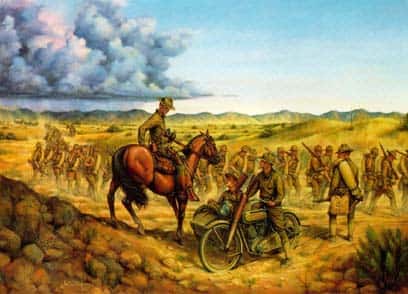>USBP History Part 6
But again, Villa attacked on March 9, 1916, and within seven days America’s military was on the move. In seven days General Blackjack
Pershing mounted what was to be the largest unified cavalry force in all of American history. It was also to be the very last massed cavalry action in the history of the United States Army.
This Villista attack of 1916 was but the largest of hundreds if not thousands of such attacks against the United States since the start of Mexico’s revolution of 1910. This revolution would continue until 1920. More than a million Mexicans died in that civil war (about ten percent of Mexico’s population). The utter tragedy of that period in Mexican history can only be understood when we consider that most of these million deaths were at the hands of other Mexicans who killed their brothers not with guns but with farm implements. An accurate count of American deaths — as this civil war coursed back and forth across our southern border — is impossible to determine.

This was America’s first use of motorized machines in war. Here we have National Guardsmen even on motorcycles deep in Mexico.
This Villista attack forever changed America’s attitude toward Mexico. Mexico suddenly was no longer the Land of Enchantment
but instead a safe haven for bandits and murderers.
This is not to say that America did not have a morbid fascination for these goings on, we did. As the Rwandan-like catastrophe of Mexico continued, various America film companies tried to capitalize on it. Just between 1913 and 1916 there were a dozen fictional movies made of the banditry and five fairly good movie documentaries. Mutual Films Corporation (a decade later to become part of RKO) paid Pancho Villa $25,000 to be allowed to film the violence he brought upon people. Part of their contract was that he should attack in daylight if possible.
The costs of this banditry and violence to the United States were tremendous. The Panama Canal had just been completed and the nearest large harbor in the United States to support that miracle of technology was in San Diego, Californa. There were great hopes that San Diego — having one of the finest harbors in the world — would gain vast wealth from canal traffic. There was even a Panama Exposition in San Diego celebrating the opening of the canal.
In fact, the threat of bandits, Mexican Army invasions, and worse, were so real to America that San Diego’s natural harbor was ignored. The new harbor to support the Panama canal was built a safe 100 miles to the north in Los Angeles. But Los Angeles did not have a harbor. To protect America’s future commerce from the continued violence, a harbor was built off a barren beach. The new harbor cost the equivalent of 10% of the entire net worth of Los Angeles county and took fifty years to build.
The machinations of the politicians to get this accomplished make the Los Angeles water authority (celebrated in the movie Chinatown) look like kindergarten schemes. You can see the result today on any Los Angeles city road map. Los Angeles harbor is part of the city of Los Angeles and is connected to the city 14 miles away by a single thread of city land
sometimes not even 50 yards wide.
